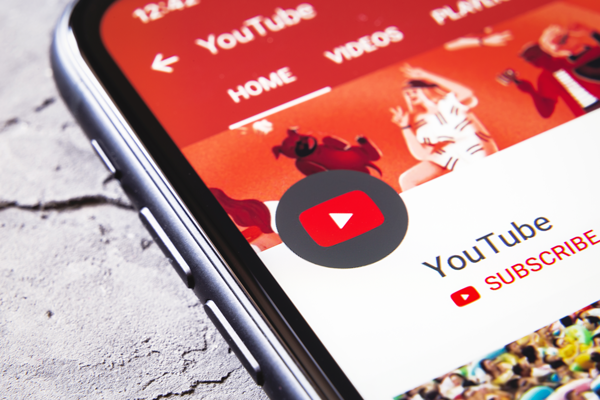This is the second time we’ve done a study on video rankings in Google and YouTube (see the first study here). This post covers:
- How YouTube videos dominate the top videos in Google’s results.
- The difference between YouTube’s and Google’s algorithms for ranking videos.
- An analysis of how the two algorithms differ.
- A short and concise YouTube Video Optimization Checklist.
- A short and concise Google Video Optimization Checklist.
Here are the top findings and takeaways from this year’s study:
- YouTube videos dominate the videos rankings within Google. This is particularly notable in the video carousels.
- The video ranking algorithms on YouTube and Google are fundamentally different.
- The optimum approach for ranking videos on both YouTube and Google requires an understanding of how the two algorithms are different.
Keep reading for more details and insights.
Brief Methodology Overview
We pulled the YouTube rankings for 6,145 search queries; 6,041 of those queries also had videos showing in the Google search results. Next, we pulled the Google rankings for the same 6,145 search queries and captured 100 results per query. Our goals were to evaluate YouTube’s dominance in the Google SERPs and how video rankings vary between YouTube and Google.
For example, in the Google results we saw for the query “12 angry men,” the Google search results displayed a video widget in position three in the search results. There were four YouTube videos in this widget. One might assume that these would be the first, second, third, and fourth ranking videos in YouTube, but that’s not the case:
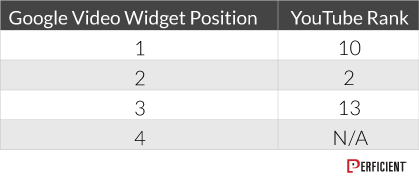
In fact, the rank order in Google looks unrelated to the rank order in YouTube. We’ll explain why later.
YouTube Dominates the Videos Shown in the Top 10 of the Google SERPs
We evaluated the videos in each of the top 10 positions to determine the percentage from YouTube vs. other sources. As you’ll see, YouTube videos overwhelmingly appear higher in the results.
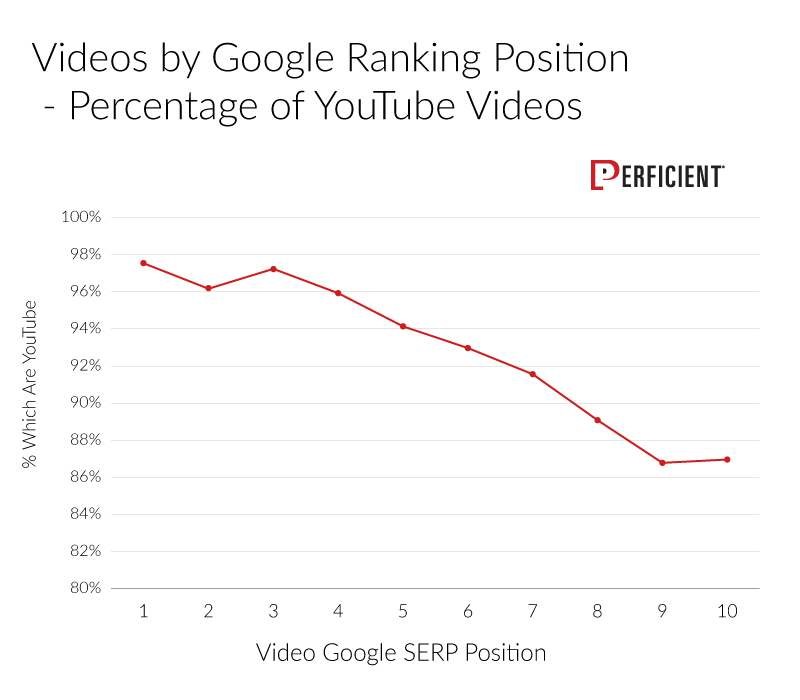
We also looked at the video rankings throughout the top 100 results. Again, YouTube videos fare better in the higher positions.
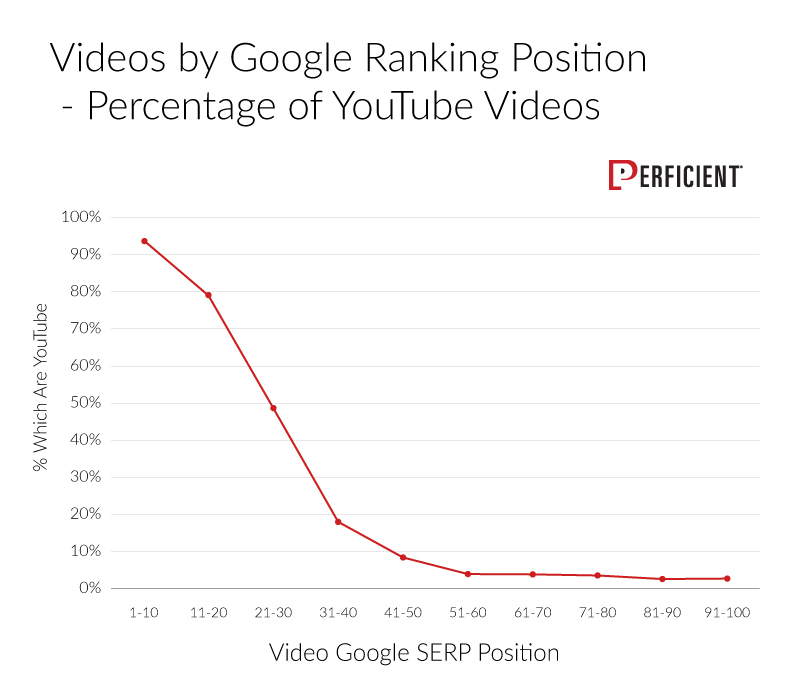
Our study accounted for featured snippets, rich snippets, video carousels, and organic results containing videos. Here are example screenshots of each type of result.
- Featured Snippet
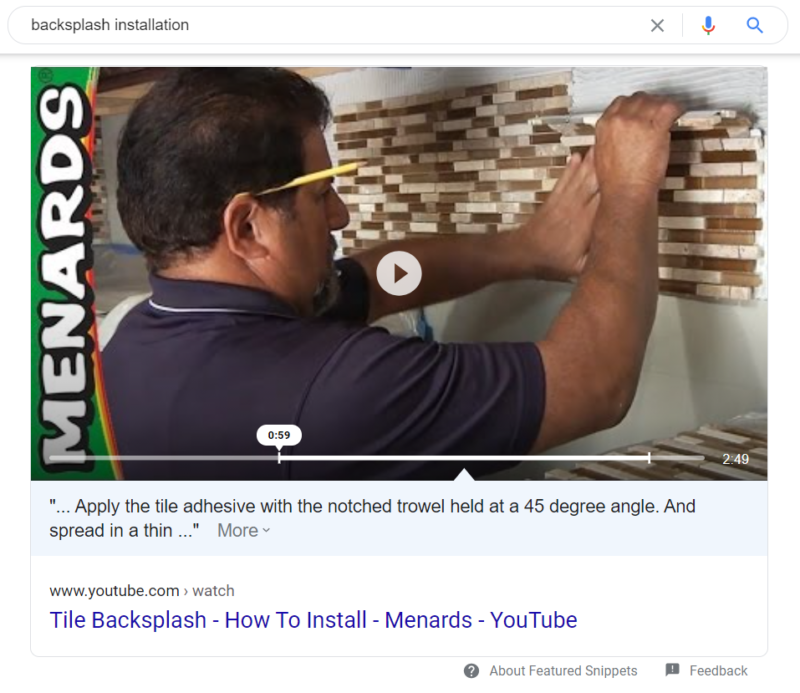
- Rich Snippet

- Video Carousel
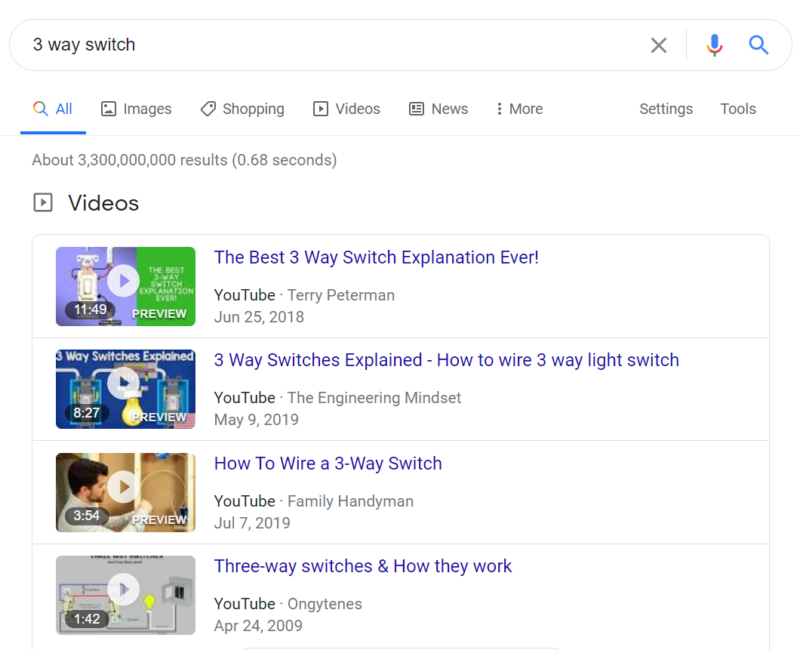
- Organic – the URL takes you to a video
In the Google SERPs, the vast majority of YouTube videos (83%) appear in the video carousel. Here’s the makeup of where the YouTube videos were found:
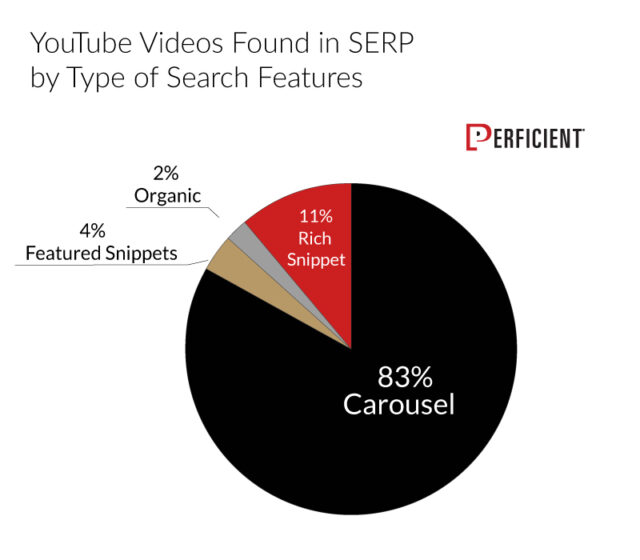
However, non-YouTube videos appear in the carousel only 21% of the time. They are far more likely to appear in the organic results as illustrated below:
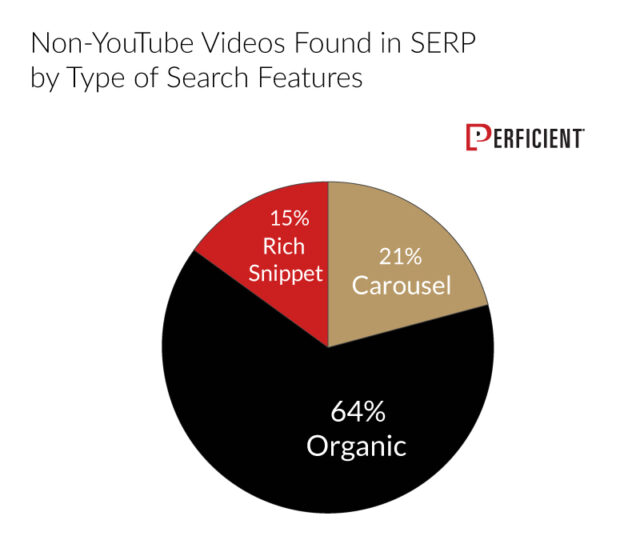
Looking at this further, non-YouTube videos tend to rank more in organic SERPs than YouTube videos:
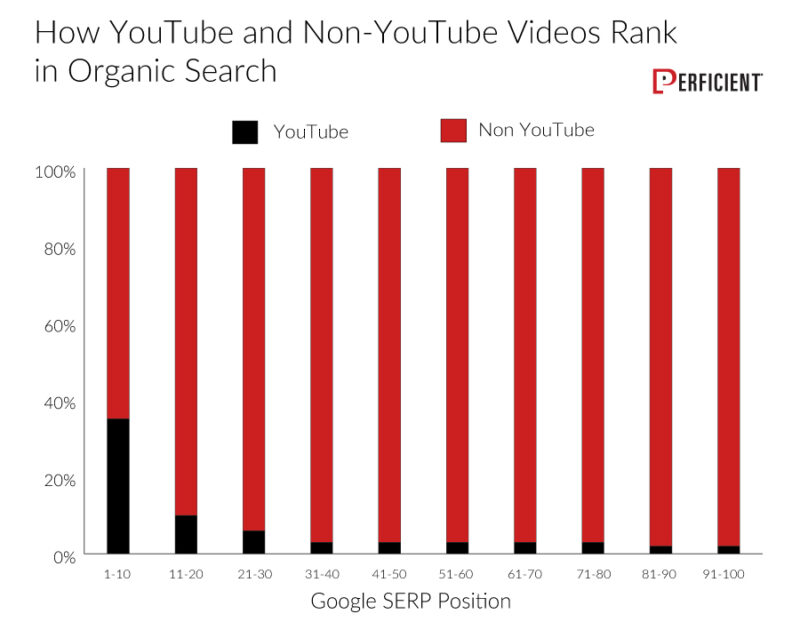
But, in rich snippets, YouTube videos tend to do better:
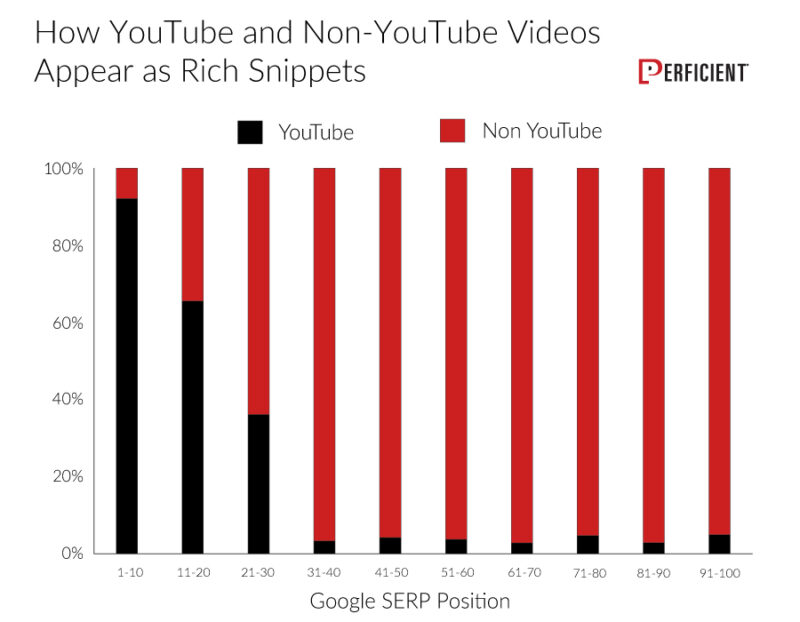
When we look at video carousels, the results greatly favor YouTube videos.
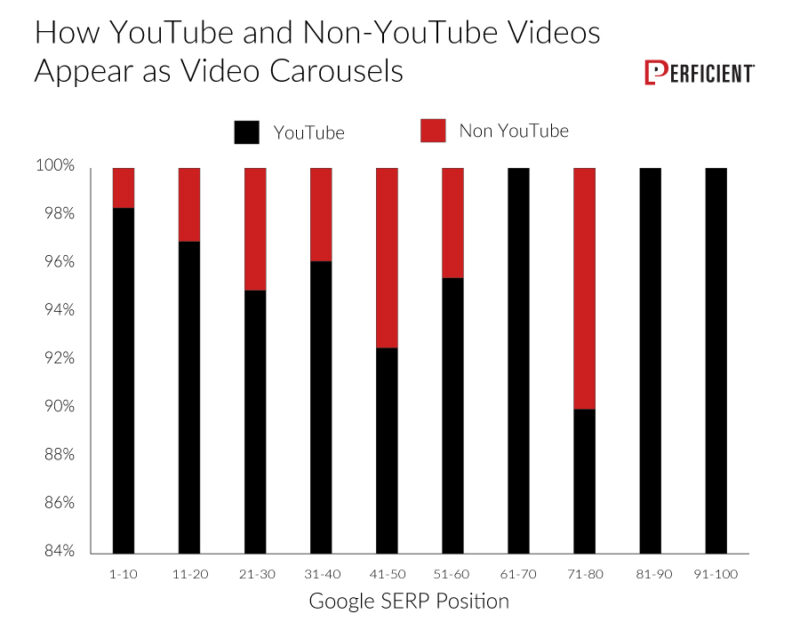
Finally, YouTube also dominates the videos in featured snippets. Across 710 featured snippets with videos that we saw in our data, all of them were YouTube videos.
In summary, YouTube’s dominance of high-ranking videos within Google does segment itself into specific areas, such as video carousels, featured snippets, and rich snippets. Other video sources perform much more strongly in the regular organic search results.
Illustrating the Difference Between YouTube’s and Google’s Video Ranking Algorithms
First, a little more background information. Out of 6,145 queries, 92 of them returned just one YouTube video in the top 100 Google results. The remaining 5,931 queries returned more than one video. The highest number of videos returned in one query was eight.
Now, let’s get to the hardcore data. The top-ranking YouTube video in Google was also the top-ranking video in YouTube for the same query 28.8% of the time (1,736 out of 6,023 queries that contained videos). That indicates a significant difference in the overall rankings for the two search engines.
To determine if the relative order of the videos shown is different, we also looked at queries that returned more than one YouTube video in Google. For example, let’s look at how often the scenario illustrated above for “12 angry men” occurs:
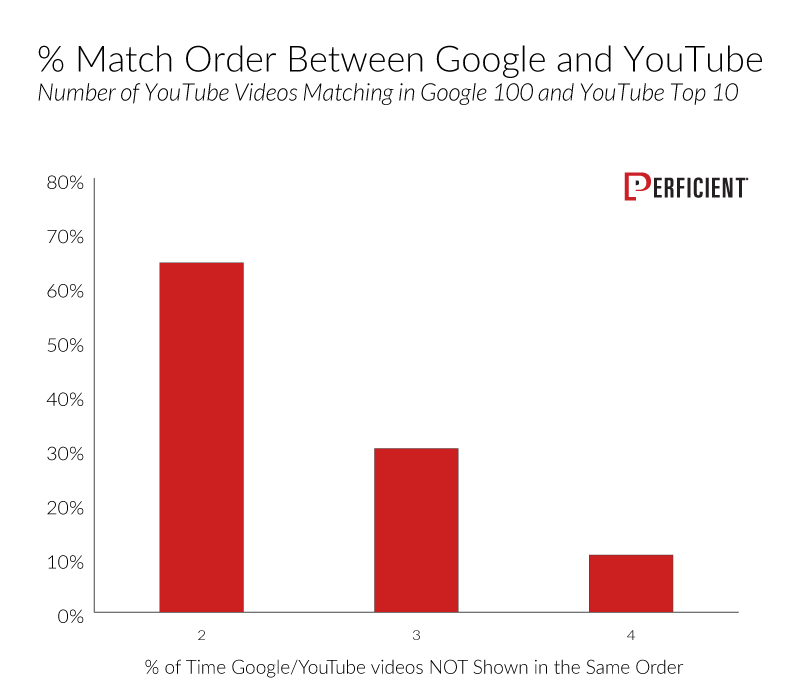
Again, the order of videos selected is different nearly two-thirds (64.3%) of the time. For clarity, this test only measures when videos show in a different relative order. To clarify, if the first, second, and third ranking videos in Google are the fourth, ninth, and 13th ranking videos in YouTube we scored this as being in the SAME relative order. Further, if the first, second, and third ranking videos in Google are the third, second, and first ranking videos in YouTube we scored this as a MATCHING order. The reason for this is that it allows us to filter out the potential for some level of perceived content relevance mismatch between the two search engines. That said, why do the two algorithms vary so much? After all, isn’t the best video the best video? The first variable is that user intent between the two platforms varies greatly depending on the type of search queries. The other major variable is that the platforms have different monetization strategies.
How Does User Intent Vary Between Google and YouTube?
In its early days, Google’s sole purpose was to provide users with links to pages in response to user queries, and the user would click on the links and leave the site. The advent of the Knowledge Graph and featured snippets changed the landscape, and more changes have followed upon these features. As a result, in some cases users don’t need to leave Google to get what they’re looking for.
Regardless, Google’s goal is to deliver a result that gives you what you are looking for on a page view basis. Everything is transactional and short-term in nature.
The other major difference is that Google is a general-purpose search engine. People search for anything, including videos.
On YouTube, the user’s goal is to watch a video. They spend time on the site consuming the site’s content and don’t leave quickly. This purpose significantly impacts the types of queries entered and how the site gets monetized. Let’s look at that next.
How Does Monetization Vary Between Google and YouTube?
Google’s monetization algorithm optimizes the value of page views served over time. You can see this in the core structure of the basic AdWords algorithm. The original core of this algorithm was that each advertiser would bid a certain amount, and the ranking order would be determined by multiplying their bid times their ad click through rate (CTR).
For example, if an advertiser bid $1 and had a 2% CTR, and a second advertiser bid $0.50 with a 5% CTR, the second advertiser would appear as the first ad. If each ad gets shown 100,000 times, which one would produce the most revenue? Let’s see:

Google’s current algorithm is simpler and includes factors like ensuring the relevance of the ad to the ad group, relevance of the ad text to the query, landing page relevance and quality, and historical account performance. These factors are combined with your clickthrough rate into a metric called Quality Score and help improve the overall user experience with ads.
Why does Google care? Shouldn’t they just optimize on CTR and bid price to maximize short term revenue?
It’s actually important that they don’t. Excess monetization would lead to a poor user experience and an erosion of market share over time. Google may be the dominant “traditional” search engine, but users can get answers to their questions by other means (asking friends, Facebook, Amazon, Bing, texting, and messaging platforms).
Ultimately, the relevance and quality score algorithms create as many “satisfied page views” as possible and help preserve Google’s market share in the face of strong competitive forces. This is accomplished by creating the largest possible amount of “satisfied page views.” These aspects also drive Google’s organic ranking factors, which are still determined by relevance, links, and direct or indirect user satisfaction with the content.
Monetization on YouTube is more complex and has an obvious core difference. When a user starts a video on YouTube, the initial action tends to be to sit back and watch. The user is not looking for an instant answer or to click on something and leave the page.
YouTube’s ad formats come into the experience at different times and in different ways. They, either as ads that show before your video begins, on the right rail, or as an overlay within the video itself. Ads can also appear in the YouTube search results and in the suggested videos during or after the current video ends.
Given the nature of the ads, view times and number of videos viewed drive the most value for YouTube. Long term market share for YouTube is ensured by Google via other metrics indicating satisfaction, including comments, likes, shares, and embeds.
Recently, growing evidence shows that YouTube is placing increased weight on freshness, too. YouTube’s advertising falls into the class of “interruption advertising”, much like traditional TV advertising. What that means is you’re there to do one thing, and the ads are trying to entice you to do something else.
In contrast, Google’s ads can provide the source of the answer the user wants and are not necessarily an interruption. For that reason, YouTube’s business model is based on Cost Per View (CPV), not a CPC.
Read more about how CPV bidding in YouTube works. According to the article, this is how you’re charged: “A view is counted when someone watches 30 seconds of your video ad (or the whole video if it’s shorter than 30 seconds) or interacts with the ad, whichever comes first.”
According to Mark Traphagen, an ad interaction includes “clicking an annotation or end-screen link in the video, clicking a link in the video description, or liking or sharing the video.”
The YouTube Video Optimization Checklist
optimize individual videos. The work starts before you film the video with raw keyword research to identify topics in high user demand.
From a YouTube perspective, this means keywords that make sense for your business and where the existing YouTube videos have a reasonable number of views. Start by doing keyword research the same way you would for Google (using your favorite keyword research process). You can also type related terms into the YouTube search box to see what autocomplete suggestions appear.
Finally, check the top videos that currently come up for your keywords. If the current ranking videos have huge view numbers and come from top accounts with a large subscriber base, the topic might be too competitive for small businesses to chase on YouTube.
Reviewing what type of content is currently ranking will help you determine:
- How YouTube sees the user intent related to those queries.
- What length of video seems like a fit.
- The best content for your video.
If the results are varied and the collection of videos seems a bit off-topic, then that suggests your opportunity to rank with a video highly focused on the user query/intent may be greater.
Then, when you script and film the video, bear in mind that the No. 1 factor in YouTube’s algorithm is user engagement. These components include:
- How long they watch your video.
- If they move on from watching your video to watching another video (this is a positive).
- Video view count.
- Share count.
- Channel subscriber count.
- Links and embeds on other sites.
For these reasons, making great video content can be hard. If the video is a straightforward, how-to video that is topic, and you deliver the content simply and clearly, that can be good enough. Once the video is created, follow these five steps:
- Pick a descriptive file name for the video.
- Choose a compelling title.
- Select a strong set of related tags.
- Write a detailed and complete description of at least 200 words.
- Place your video in an appropriate category.
To succeed, you must:
- Establish video relevance. YouTube and Google use this information to understand which queries your video fits.
- Entice the user to start watching. Don’t shortchange this part—getting your view count up is critical.
These final steps help drive views to your video and can help it rank. Consider writing a blog post and embedding the video in it. Promote the blog post using these steps (or do each of these steps individually):
- Organic social promotion
- Paid social promotion, including on YouTube
- Email the video to subscribers
- Get third-party sites to embed the video
If you’re an active member on social sites like LinkedIn, Facebook, or Quora, post your video on your page. Building your subscriber base over time will help get the video out to people quickly, too.
Driving views and view time by any means possible can impact organic ranking, which differs from Google’s rankings. Our “Here’s Why” video series sees more organic viewing traffic when we promote it via YouTube ads.
Unlike Google, YouTube effectively lets you buy organic rankings. To be fair, it’s an indirect effect. You’re not directly buying rankings, but your paid campaigns can positively impact the signals that YouTube looks at, like view time.
The Google Video Optimization Checklist
The basics of YouTube video optimization—file name, title, description, tags, and video category—still apply when you’re optimizing for Google. What doesn’t apply is video engagement and the process for keyword research and topic selection.
Google is a broad-based platform, so its use of video is limited compared to YouTube. As noted in our examination of 424 queries that returned videos, only one had as many as five videos in the top 100 results, and only 21 (5%) of the queries had more than two videos in the top 100. That’s pretty sparse.
When selecting topics, spend time figuring out where the real opportunities are in Google. It turns out that there are certain classes of queries commonly have one or more videos on the first page of Google results, including:
- Informational videos
- Tutorials
- How-tos
- Reviews
- Entertainment
Commercial terms are not included in that list. Remember, your video presence in Google is not about direct conversion—after all, the video will be viewed on YouTube, not your website.
Keep in mind, if Google wants to show a video or two in their organic search results, that’s a spot that your website won’t be competing for in the SERPs. If someone is going to occupy it, it might as well be you. Any commercial value extracted from that spot in the SERP will be yours—plus, it’s great branding.
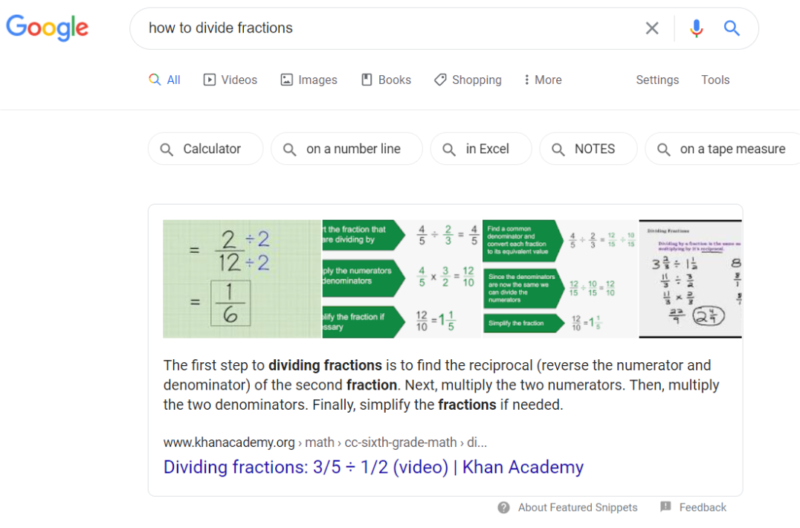
From a keyword research perspective, you still want to find keywords with some volume that have strong semantic relevance to your business. You can tune your campaign based on your goals, too.
For example, is your primary goal to build your reputation? Informational/how-to videos may be your best target. Are you looking to drive email subscriptions? An ongoing series of videos may be your best approach. Whatever you pick, make sure that Google currently shows a video on the first page for that phrase that you can reasonably take from the incumbent.
The next step of the process exposes how Google is different than YouTube. Google places more weight on traditional ranking signals, such as relevance and importance (links). Set your course by taking these steps:
- Send strong relevance signals. Basic YouTube optimizations—such as file name, title, and description—can help you send strong relevance signals to Google. Reinforce those signals by promoting it in your blog post, social media, and elsewhere. Try to send out stronger signals than the competing videos without being spammy.
- Get links to your video. Yes, these still matter. Getting your video some links helps drive your video’s chances of ranking in Google.
To support the importance of getting links, a Spearman correlation analysis was conducted on our data to determine how links impact the chances of videos ranking in Google and how they would rank. A Spearman correlation value of 0.50 was obtained. That’s a high value—any value over 0.3 indicates a significant correlation. Note, a very high degree of relevance matters a great deal, and we saw many instances of videos with weaker link profiles outranking other videos due to higher relevance.
To handle the Spearman calculation:
- Take the square of the rho value for each individual result.
- Sum those squares. If the rho value is negative, subtract it from the sum, rather than add it.
- Take the square root of the total.
Summary
We’ve shown that YouTube videos are the dominant source of videos shown in Google’s top positions. In addition, the difference between the two ranking algorithms for YouTube and Google is large. Use the principles outlined above when you begin—or continue—your video marketing strategy. Maximizing your return on investment depends on adapting a strategy that works well on both platforms.
